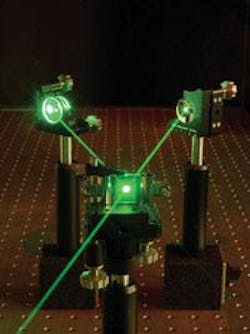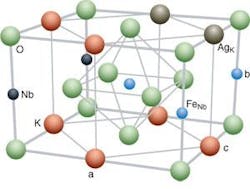Nonlinear Optics: Research continues to advance photorefractive beam coupling
DEAN R. EVANS AND GARY COOK
The photorefractive effect is unique in the world of nonlinear optics. Unlike most nonlinear materials, the optical response in photorefractives is generally independent of intensity. This unusual property allows many applications to be realized using low-power, continuous-wave lasers, which makes photorefractive materials an ideal partner for emerging solid-state laser sources.
Nevertheless, photorefractive research has been in decline for the past decade, mainly because of a failure to produce the wide range of devices and applications promised by the researchers of that time. This failure was essentially due to the immaturity of the available photorefractive materials. Although the concepts were sound, the material development generally did not support the demands of the emerging applications.
The photorefractive community has become smaller over the past decade and funding for research has become scarce. We have recently seen a crystal-growing company known for its Fe:LiNbO3 crystals (a popular photorefractive and photovoltaic crystal) discontinue growth of this material. However, even though funding has decreased throughout the photorefractive community, the work has not stopped completely. New emerging ideas are improving existing crystals and in some cases uniting the competitive fields of organic and inorganic photorefractive materials in a single device.
Photorefractive materials have been investigated for many electro-optical applications, such as data storage, optical interconnections, holographic optical filters, associative memory, and phase conjugation.1-5 A key application that has been extensively studied is beam coupling, in which power is transferred from one laser beam to another through the recording of either transmission or reflection gratings.6 Both photorefractive gain and response time are important parameters in this application. Very large gain coefficients and fast response times have been achieved independently, but as yet these parameters have not been obtained in a single material.7
Modus operandi
Photorefractive gratings are created when two laser beams form an interference pattern within the photorefractive material. In the regions of light, charges are photoionized and then migrate to the dark regions where they become trapped in charge acceptors. The redistribution of charges leads to a periodic space-charge field. Through the electro-optic effect (linear Pockel’s effect) the index of refraction of the material is modulated by the space-charge field, resulting in a photorefractive grating. If the grating is phase shifted with respect to the optical interference pattern, power is transferred from one beam to the other, with maximum efficiency when the phase shift is 90°. The angle between the interfering laser beams can be small when recording a transmission grating, or large (180°, counterpropagating) when recording a reflection grating.
In our work with reflection gratings, a “self-pumping” configuration is used to record a real-time hologram. The two laser beam sources are the incident beam (pump) and its counterpropagating Fresnel reflection from the rear surface (signal). In the case of two-beam coupling in transmission gratings, two incident laser beams (pump and signal) are separated by an angle that depends on the trap density of the inorganic photorefractive material-typically about 20° with cerium-doped strontium barium niobate (Ce:SBN).
Power transfer occurs in a single direction, which is determined by the signs of the charge carriers and the effective electro-optic coefficient for a given crystal orientation. Depending on the crystal orientation with respect to the grating k-vector, either the pump or the signal beam can be amplified at the expense of the other by a power transfer caused by the photorefractive two-beam coupling process. This produces a reduction of power in one direction and an increase in the opposite direction; under ideal conditions almost complete power transfer from one beam to the other can result.
Improving gain
In our current work at the Materials and Manufacturing Directorate of the Air Force Research Laboratory, we are striving to improve the photorefractive gain for enhanced two-beam coupling using two distinct approaches: improving well-known inorganic photorefractive materials by doping impurities into lattice sites other than those that have been used previously,8 and exploring the hybridization of inorganic photorefractive or photoconducting crystals with high birefringence organic materials such as liquid crystals.9 For the former case we have put emphasis on potassium niobate (KNbO3) because we have some control over the lattice site where the impurities enter. For the latter, inorganic photorefractive Ce:SBN substrates were used because of their relatively simple diffusion-driven photorefractive effect.10 In both approaches, two-beam coupling occurs through real-time holographic techniques without the need for an external voltage source.
In the first approach of improving well-known photorefractive materials, iron-doped potassium niobate (Fe:KNbO3) was chosen because of its desirable photorefractive properties, but also because the two typical sites for doped impurities are very different in nature. It is understood that photorefractive centers (Fe, for instance) in KNbO3 substitute for the niobium (Nb) site (FeNb = Fe on a Nb site).11 Unlike common dopants in KNbO3 crystals where potassium sites (KK) remain unaffected by the incorporation of impurities, silver (Ag) ions replace K ions (AgK) and play a significant role in the perturbation of the main photorefractive donor site (FeNb). Potassium has a relatively large ionic radius and a +1 charge, whereas niobium is almost half the size of potassium with a charge of +4 or +5.
After trying several potential candidates with a similar size and same charge as potassium, we have found that the substitution of silver for potassium yields the best results. In the lattice structure of KNbO3, some of the Nb sites are replaced by Fe ions and some of the K sites are replaced by Ag ions (see Fig. 1). We attribute the increased photorefractive gain and reduced response time to the perturbation of Fe by the AgK as well as a possible increase in the effective trap density due to the incorporation of the silver ions.
Because of the perturbed Fe, there are significant enhancements to the electrical and optical properties (that is, photocurrent, photovoltaic field, and linear absorption). And because of the change in the material properties of the modified crystal (Ag,Fe:KNbO3), the counterpropagating two-beam coupling efficiency has increased by nearly two orders of magnitude compared to singly doped Fe:KNbO3 crystals, and has a 1/e response time of less than a few hundred microseconds.
Flexoelectric effect
For the second approach to increase the photorefractive gain, we are hybridizing inorganic photorefractive crystals with high-gain liquid crystals.Hybrid organic/inorganic materials represent an exciting new area of research in which surface charges originating from an inorganic layer change the optical properties of an adjacent organic layer.
In this arrangement the charge migration, space-charge field, and trap density are primarily determined by the inorganic photorefractive materials. The liquid-crystal molecules are slaved to the resulting space-charge field, amplifying the overall refractive-index modulation by aligning themselves with the space-charge field. The refractive index of liquid crystals depends on the alignment of the molecules.
For liquid crystals to achieve Bragg matching they must have a broken molecular-alignment symmetry and a molecular polarity-this is achieved by combining a pretilt of the liquid crystals with the flexoelectric effect. This approach allows the efficient space-charge field and large trap density of the inorganic substrates to complement the organic material. Liquid crystals lack a sufficient trap density for strong two-beam coupling in the Bragg regime, although they are capable of a much higher gain than any known inorganic material due to their high birefringence.
In this way, a large two-beam coupling gain with full Bragg matching can be achieved even when the cell thickness is about 10 µm. Photorefractive two-beam coupling is demonstrated in a liquid-crystal cell comprised of a pure liquid crystal between two Ce:SBN windows (see photo, p. 67). Unidirectional beam coupling is achieved in the Bragg regime with a gain of more than 470 cm-1 at about 1.3 µm through a transmission grating. This is believed to be the highest Bragg-matched gain coefficient for any photorefractive material, with grating spacings ranging from about 400 nm to 5 µm. This method also allows the spectral range for photorefractive beam coupling to be extended through the use of combinations of different photorefractive and photoconducting inorganic substrate materials.
We expect that photorefractive materials have a bright future. Recent progress and the resurgence of interest in this field with our collaborators have helped to reignite the photorefractive research community. We hope that through collaborative efforts, mature materials and innovative concepts will help many photorefractive applications see the light of day.❏
ACKNOWLEDGMENT
The authors would like to acknowledge the other two members of the Materials and Manufacturing Directorate photorefractive in-house research team: Mohammad Saleh (UES; Dayton, OH), and Jennifer Carns (Anteon; Dayton, OH).
REFERENCES
1. F.S. Chen, J.T. LaMacchia, D.B. Fraser, Appl. Phys. Lett. 13, 223 (1968).
2. J. Wilde, R. McRuer, L. Hesselink, and J. Goodman, SPIE752, 200 (1986).
3. G.A. Rakuljic, V. Leyva, Opt. Lett.18, 459 (1993).
4. B.H. Soffer, G.J. Dunning, Y. Owechko, E. Marom, Opt. Lett.11, 118 (1986).
5. S.M. Jensen, R.W. Hellwarth, Appl. Phys. Lett.33, 404 (1978).
6. L. Solymar, D.J. Webb, A. Grunnet-Jepsen, The Physics and Applications of Photorefractive Materials, Oxford Series in Imaging Science 11, Clarendon Press, Oxford, 1996.
7. G. Cook, C.J. Finnan, D.C. Jones, Appl. Phys. B,68, 911 (1999).
8. D.R. Evans, G. Cook, J.L. Carns, M.A. Saleh, S.A. Basun, J.M. Seim, G.J. Mizell, Opt. Lett. In press (2005).
9. G. Cook, J.L. Carns, M.A. Saleh, D.R. Evans, Molecular Crystals and Liquid Crystals, In Press (2005).
10. J.Y. Chang, et al., Appl. Phys. Lett.72, 2199 (1998).
11. E. Siegel, W. Urban, K.A. Müller, E. Wiesendanger, Phys. Lett.53A 415 (1975).
DEAN EVANS is the leader of the Photorefractive Group at the at the Air Force Research Laboratory Materials and Manufacturing Directorate, Wright-Patterson Air Force Base, Ohio 45433; e-mail: [email protected]. GARY COOK is a senior scientist in the Materials and Manufacturing Directorate employed by Universal Technology Corp. (Dayton, OH).


